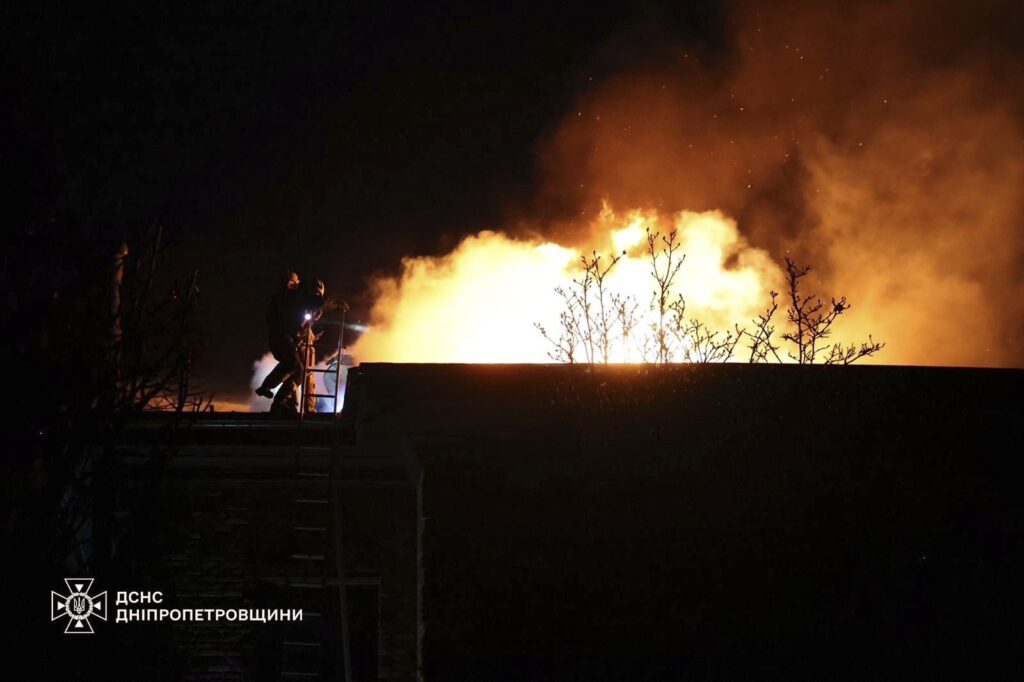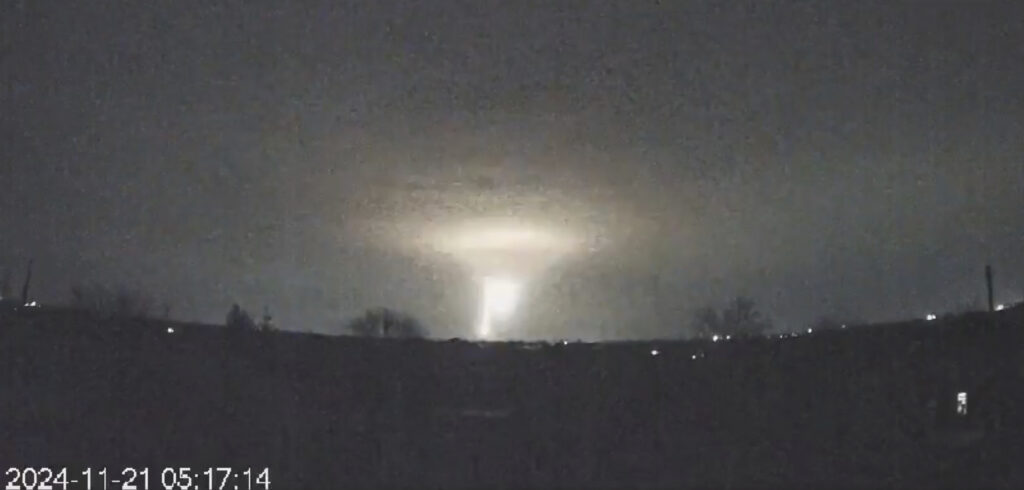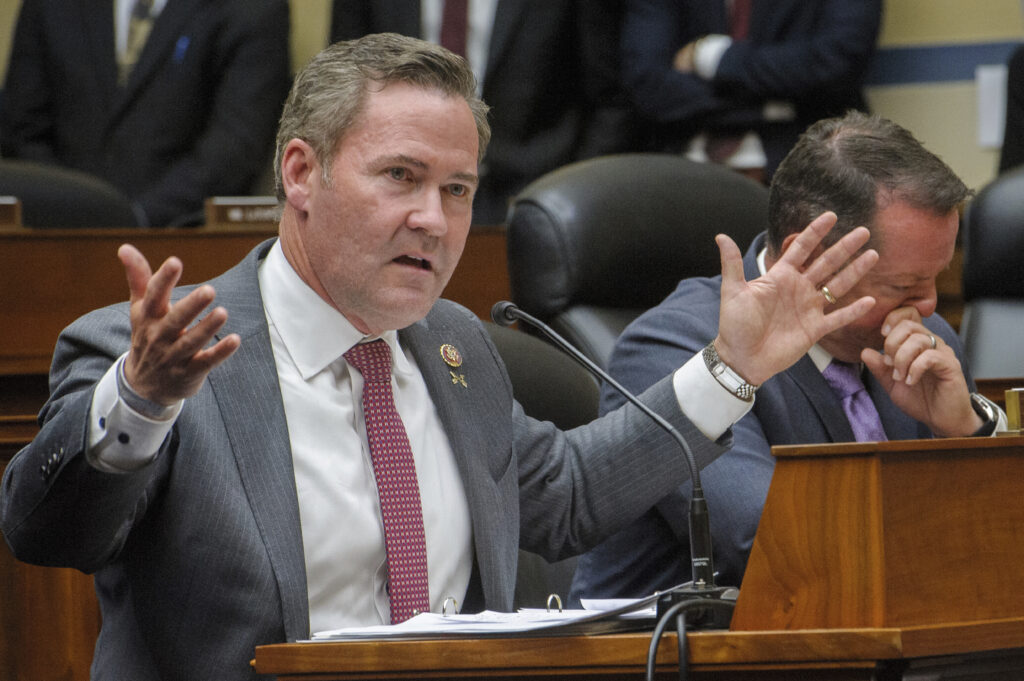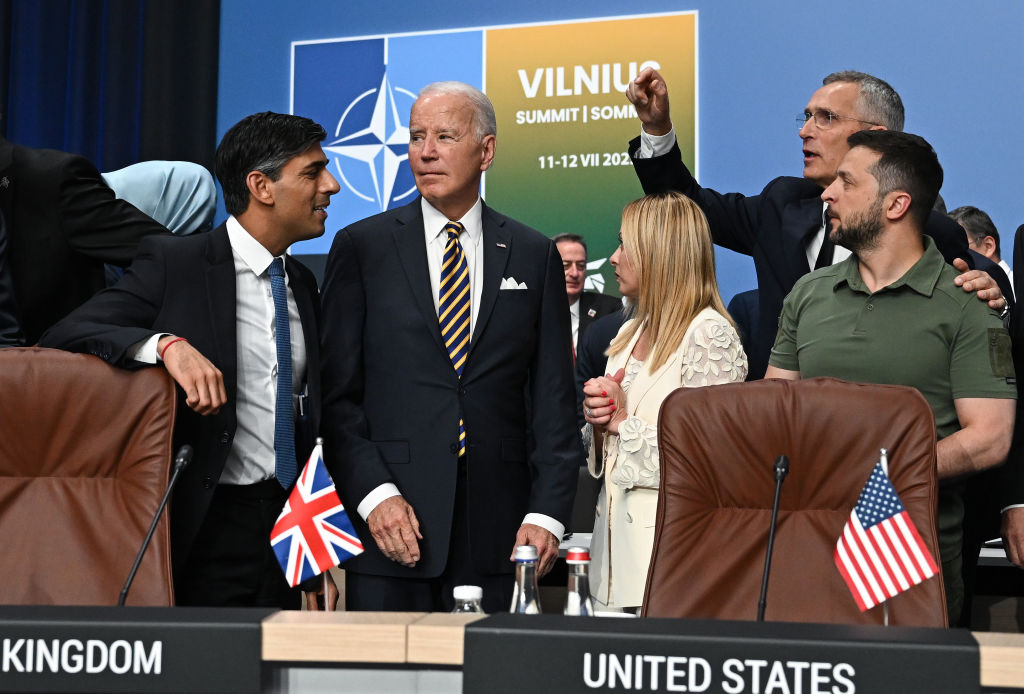Russia and Ukraine, in Runup to Trump Inaugural, Trade Signals Through Rockets
Germans respond with what Bild calls ‘der Bunker-Plan für Deutschland.’

The North Atlantic Treaty Organization and Ukraine meet today at Brussels to craft a response to Russia’s unprecedented use of a hypersonic, nuclear-capable missile against Ukraine. In a chilling scene evocative of the 1983 nuclear movie “The Day After,” a video of Russia’s attack showed a flash lighting up clouds over Dnipro last Thursday night. Then, multiple warheads streaked to the ground.
Designed as a signal to Europe, the missile carried only dummy warheads. It wrought only minimal damage on the intended target, Ukraine’s preeminent rocket engine factory, Pivdenmash, better known as Yuzhmash. Fishing in a Cold War era alphabet soup, Russia’s president deliberately chose an intermediate-range ballistic missile, or IRBM, over an intercontinental ballistic missile, or ICBM, to send a message to Europe.
An ICBM would have the capacity to hit America’s East Coast, sending a hostile message to President-elect Trump. An IRBM would fall short, splashing into the Atlantic. It could, though, hit such capitals as Warsaw, Berlin, Paris, and London.
“Europe is wondering what damage the system can cause if the warheads are nuclear, whether it is possible to shoot down these missiles, and how quickly the missiles will reach the capitals of the Old World,” Russia’s former president, Dmitry Medvedev, clarified Sunday in a Telegram post.
“The answer: the damage is unacceptable,” he wrote. “It is impossible to shoot down with modern means, and we are talking about minutes. Bomb shelters will not help.” The weapon has a top speed of 8,000 miles an hour.

Regardless, a German Interior Ministry spokesman said yesterday his government is surveying basements, underground car parks and subway stations for conversion into bomb shelters. This civil defense plan would include construction of shelters capable of giving quick refuge to up to 5,000 people at a time.
Bild headlined the project: “Der Bunker-Plan für Deutschland.”
Russia’s fear is that Europe rearms. Trump has repeatedly said that America is tired of footing the bill for European defense. With the clock ticking until the January 20 inauguration, European officials are negotiating feverishly to draw up investment plans for their own defense.
“Russia produces as many weapons and ammunition in three months as the entire EU does in a year,” Germany’s defense minister, Boris Pistorius, complained recently. President Macron of France asserted this month: “We need to be able to defend ourselves.” He warned that Europe must not become a “herbivore” surrounded by “carnivores.”
Today’s meeting at Brussels of NATO with Ukrainian officials will be part of that process. Increasingly, Europeans see Ukraine as a dike crucial for blocking a westward expansion by Russia. Last week, Denmark hosted defense ministers of 12 European countries to finance weapons production in Ukraine.

This “Northern Group” consists of Britain, Germany, Poland, the Netherlands, Iceland, Sweden, Denmark, Finland, Norway, Estonia, Latvia, and Lithuania. After years of browbeating by Washington, 24 of NATO’s 32 member nations this year are meeting the target of devoting 2 percent of GDP to defense.
Contrary to the American view of Europe’s freeloading, the Kiel Institute for the World Economy reports that since February 2022, America has given Kyiv nearly $70 billion in military aid, while Europe has given nearly $90 billion.
Le Monde reported yesterday that France and Britain are mulling sending soldiers to Ukraine, most likely trainers or advisors. Earlier this month, the Biden Administration decided to send military contractors to Ukraine to maintain F-16 fighter jets and Patriot air defense systems in areas far from the front lines.
A top priority for the incoming Trump Administration will be to unravel this increasingly complex conflict, Representative Michael Waltz, Trump’s pick for national security advisor, told “Fox News Sunday.” He pointed to Russia’s use of a hypersonic weapon, North Korean troops fighting alongside Russian troops, South Korea weighing intervention, and the decision by the Biden Administration to allow Ukraine to fire American-made tactical ballistic missiles, known by the acronym Atacms, as far as 190 miles into Russia.

“It’s another step up the escalation ladder, and no one knows where this is going,” Mr. Waltz warned last week on Fox News. On Friday, a retired American lieutenant general, Keith Kellogg, had a different take, saying the move has “actually given President Trump more leverage.”
The decision “does give President Trump more ability to pivot,” General Kellogg, who was Vice President Pence’s national security adviser, told Fox News. “Now he can pull back. He can go left. He can go right. He can do something.”
On Friday, the speaker of the Russian Duma, Vyacheslav Volodin, made more threats. “The authorization by the United States and its allies to use Western-made long-range weapons against our country once again confirms that NATO is at war against Russia,” he wrote on Telegram. “Without their military specialists and satellite data, it is impossible to aim and activate the weapons.”
“Such actions will be met with a response,” he wrote. “And a more powerful one at that. Politicians in Western countries need to ask themselves: are they ready for this and are they aware of the consequences?!”
However, Western markets seemed to shrug off last week’s hypersonic attack as the latest act of nuclear brinkmanship by Mr. Putin. Yesterday, the Dow Jones Industrial Average surged 400 points to a record high, largely on news of the nomination of hedge fund manager Scott Bessent as Treasury Secretary. Over the last two weeks, the ruble has lost 8 percent against the dollar, largely in response to growing Western banking and shipping sanctions.
Without air defense capable of stopping a hypersonic missile, Kyiv cancelled Friday’s session of the Rada, or Parliament. However, Ukraine’s leaders are betting that the Kremlin will not go nuclear before Trump is inaugurated.

Yesterday, Kyiv sent a wave of drones 320 miles northeast of Ukraine, almost double the range of Atacms. The drones hit a major oil tank farm at Kaluga, damaging four tanks and setting off a major fire. Also, at Kaluga, Ukrainian drones started a fire at Typhoon, a military missile parts manufacturer.
Over the last three days, Ukraine has fired five Atacms at military targets in Kursk, the Russian region where Ukraine has been fighting since August. On Saturday, three American-made missiles took out an S-400 air defense system, killing five officers and three representatives of the manufacturer.
Yesterday morning, two more Atacms hit an airfield at Khalino, Russia’s closest air base to the Kursk fighting. Expecting Washington to authorize use of the long range weapons, Russia preemptively moved its fighter jets out of range. However, the Khalino base was used for touch and go logistics dropoffs. Now, it may be out of action.
The missiles cost $1.3 million apiece. Ukraine has only about 100 left. Rather than run the risk of the Trump Administration rescinding permission to use the missiles on Russian targets, Ukraine is expected to use most of them up before the inauguration.

